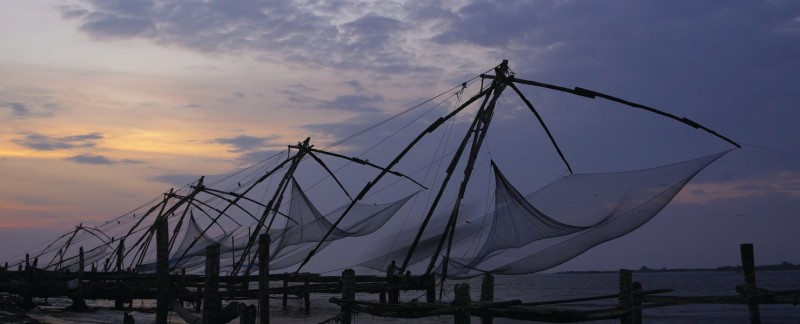Chinese fishing nets and Holiday homes in Cochin
Chinese fishing nets (Cheena vala) a few minutes walk from our Fort Kochi Homestay, are fishing nets that are fixed land installations for fishing. Huge mechanical contrivances hold out horizontal nets of 20 m or more across. Each structure is at least 10 m high and comprises a cantilever with an outstretched net suspended over the sea and large stones suspended from ropes as counterweights at the other end. In India they are mostly found in Fort Kochi and Kollam and its a great tourist attraction. These days the fishermen catch more tourist than fish 🙂
The system is sufficiently balanced that the weight of a man walking along the main beam is sufficient to cause the net to descend into the sea. The net is left for a short time, possibly just a few minutes, before it is raised by pulling on ropes. The catch is usually modest: a few fish and crustaceans — these may be sold to passers by within minutes, alive! Rocks, each 30 cm or so in diameter are suspended from ropes of different lengths. As the net is raised, some of the rocks one-by-one come to rest on a platform thereby keeping everything in balance.
The Chinese fishing nets at Fort Kochi, Vasco da Gama Square, located in the Kochi city of Kerala, make up a very popular tourist attraction. They are fixed land installations, which are used for a very unique and unusual method of fishing. Operated from the shore, these nets are set up on bamboo and teak poles and held horizontally by huge mechanisms, which lower them into the sea. They look somewhat like hammocks and are counter-weighed by large stones tied to ropes. These nets have become a hallmark that represents Fort Kochi on the tourist map. Once just a fishing accessory, it is a now a great attraction for tourists.
History of the Chinese fishing nets – Cheenavala in Malayalam – is believed to have been introduced in Kochi by Chinese explorer Zheng He, from the court of the Kubla Khan. The fishing net established itself on the Kochi shores between 1350 and 1450 AD.
The Chinese nets, made of teak wood and bamboo poles, work on the principle of balance. Each structure, about 10m high, is fixed on the beach and has a cantilever with an attached net that is spread over an area of about 20 meters. Counterweights, usually stones about 30 cm in diameter, tied to ropes of different lengths, facilitate the working of the nets. Often, lights, attached to the teak posts. are suspended above the net to attract fish.
Each fishing net is operated by more than four fishermen and is made in such a way that the weight of a man walking on the main plank is enough to cause the equipment to be pulled down into the sea. Fishing is usually done in the morning and early evening. The net is descended into the water for a short time and then raised delicately by pulling on the ropes. The slow rhythm and balancing of the net is spellbinding to a first-time viewer.
It is lovely to see Chinese fishing nets with the sun setting in the back ground. It is very interesting to see how they catching fish with these wonderful nets. In Adhakaranazhi, Kumbalanghi and vypeen you can also see the smaller vertion of these fishing nets.

